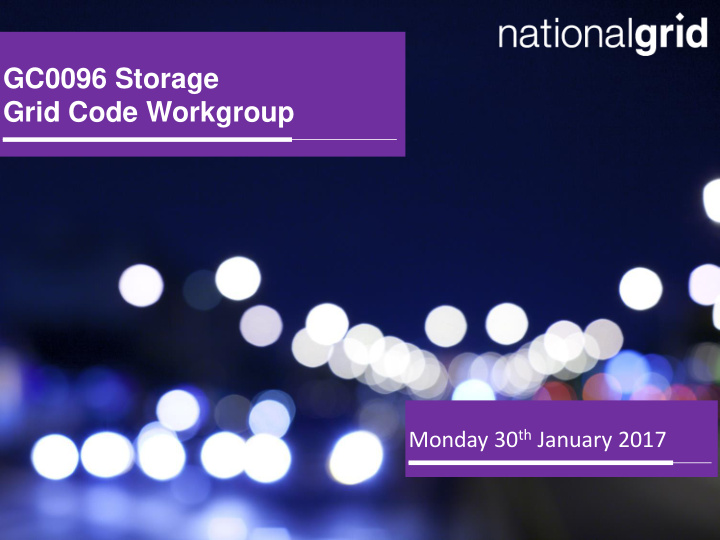



GC0096 Storage Grid Code Workgroup Monday 30 th January 2017
Contents Background to GC0096 Review/Approve Terms of Reference In/out of scope items Defining our ‘Storage’ user How should technical requirements be applied Next meeting arrangements 2
Background - Storage and the Grid Code ‘Storage’ (other than Pumped Storage) is not defined in the Grid Code. Storage connection applications continue to increase in volume - it is becoming more important therefore that the Grid Code provides technical clarity on connection requirements for new Storage schemes We are aware of many different types of Storage technologies and topologies However our aim is for transparency and consistency for all users of the Transmission System, including Storage. This means comparable technical performance requirements for users - be they Generation, Demand or Storage 3
Review/Approve Terms of Reference
GC0096 Overview A clear and precise defect has been identified Our focus is to deliver appropriate changes in a timely and efficient manner: Fortnightly workgroups with a fixed end point Catch-all meeting at the end of the cycle for interested parties to review outcomes before industry consultation Post-workgroup, we will direct interested parties to existing forums/workgroups reviewing commercial or charging arrangements for Storage. We cannot resolve these topics in a Grid Code workgroup 5
Defining a Grid Code ‘Storage’ user
Definitions Firstly, are we talking “Energy Storage” , “Electricity Storage” or both? Some ‘associated’ Grid Code terms which may help us… Onshore Generating Unit - Unless otherwise provided in the Grid Code, any Apparatus located Onshore which produces electricity, including, an Onshore Synchronous Generating Unit and Onshore Non- Synchronous Generating Unit . Onshore Power Park Module - A collection of Non-Synchronous Generating Units (registered as a Power Park Module under the PC ) that are powered by an Intermittent Power Source , joined together by a System with a single electrical point of connection directly to the Onshore Transmission System (or User System if Embedded ) with no intermediate Offshore Transmission System connections. The connection to the Onshore Transmission System (or User System if Embedded ) may include a DC Converter . 7
Definitions (cont’d) Onshore DC Converter - Any User Apparatus located Onshore with a Completion Date after 1 st April 2005 used to convert alternating current electricity to direct current electricity, or vice versa. An Onshore DC Converter is a standalone operative configuration at a single site comprising one or more converter bridges, together with one or more converter transformers, converter control equipment, essential protective and switching devices and auxiliaries, if any, used for conversion. In a bipolar arrangement, an Onshore DC Converter represents the bipolar configuration. Pumped Storage Generator - A Generator which owns and/or operates any Pumped Storage Plant Pumped Storage Plant - The Dinorwig, Ffestiniog, Cruachan and Foyers Power Stations Pumped Storage Unit - A Generating Unit within a Pumped Storage Plant 8
Definitions (cont’d) Onshore Non-Synchronous Generating Unit - A Generating Unit located Onshore that is not a Synchronous Generating Unit including for the avoidance of doubt a Power Park Unit located Onshore. Onshore Synchronous Generating Unit - An Onshore Generating Unit including, for the avoidance of doubt, a CCGT Unit in which, under all steady state conditions, the rotor rotates at a mechanical speed equal to the electrical frequency of the National Electricity Transmission System divided by the number of pole pairs of the Generating Unit. Demand - The demand of MW and MVAr of electricity (i.e. both Active and Reactive Power ), unless otherwise stated 9
What are our basic Storage definitions? How do these impact on Grid Code Technical Requirements…? Adopt similar approach to other technologies in the Grid Code 10
Storage Technologies & Topologies - Assigning technical requirements
Storage Technologies Pumped Storage (Hydro Electric) Compressed Air Energy Storage Flywheels Batteries Superconductive Magnetic Energy Storage Hydrogen Storage Systems Supercapacitors Others…? 12
Topologies Transmission Transmission Transmission System System System SU SU SU SU SU SU SU SU Storage Units connected within an Power Station Existing Power Station Comprising individual storage Power Station Devices (batteries) Comprising Storage Devices of the same type behind an HVDC Converter 13
Topologies (cont’d) Transmission Transmission Distribution System System System Configuration arrangements as per Power Stations SU SU connected directly to Transmission SU SU Storage Units connected within Storage Units connected within an Existing Power Station an Existing Power Station via Station Board (Wind Farm / Power Park Module) 14
Key questions for setting technical requirements Where do technical requirements derive for new Storage schemes? Connection Point? Other? Is there a correlation between some Storage technologies and existing Grid Code Users allowing us to deem appropriate technical requirements? For Battery/Converter-based technology = Power Park Module or HVDC converter? How do we consider Storage co-located with new or existing Generation schemes? Do requirements apply to the entire scheme, or Generation and Storage elements separately? 15
Other factors for Grid Code requirements Both static and dynamic models should be submitted by a Storage developer under the Planning Code and Data Registration Code These models must represent an accurate behaviour of the plant as built; NGET will work with developers and manufacturers on the development of these models How will availability be understood (e.g. running regime)? Will additional signals be required for operational metering purposes How do we consider EU Connection Code technical requirements? (see next slide) 16
European Codes There are x3 EU Codes which dictate Connection requirements for new users: Requirements for Generators Demand Connection Code HVDC Whilst ‘Storage’ users are not bound by these codes, to what extent do our proposals need to reflect EU standards? Do we just reflect existing (as-is) Grid Code standards? 17
Next meetings
Future meeting dates/topics 30th January 2017: Meeting 1 13th February 2017: Meeting 2 Assigning Technical Requirements 27th February 2017: Meeting 3 Assigning Technical Requirements 13th March 2017: Meeting 4 Proposed Drafting Grid Code changes 27th March 2017: Meeting 5 (If needed) 19
Recommend
More recommend